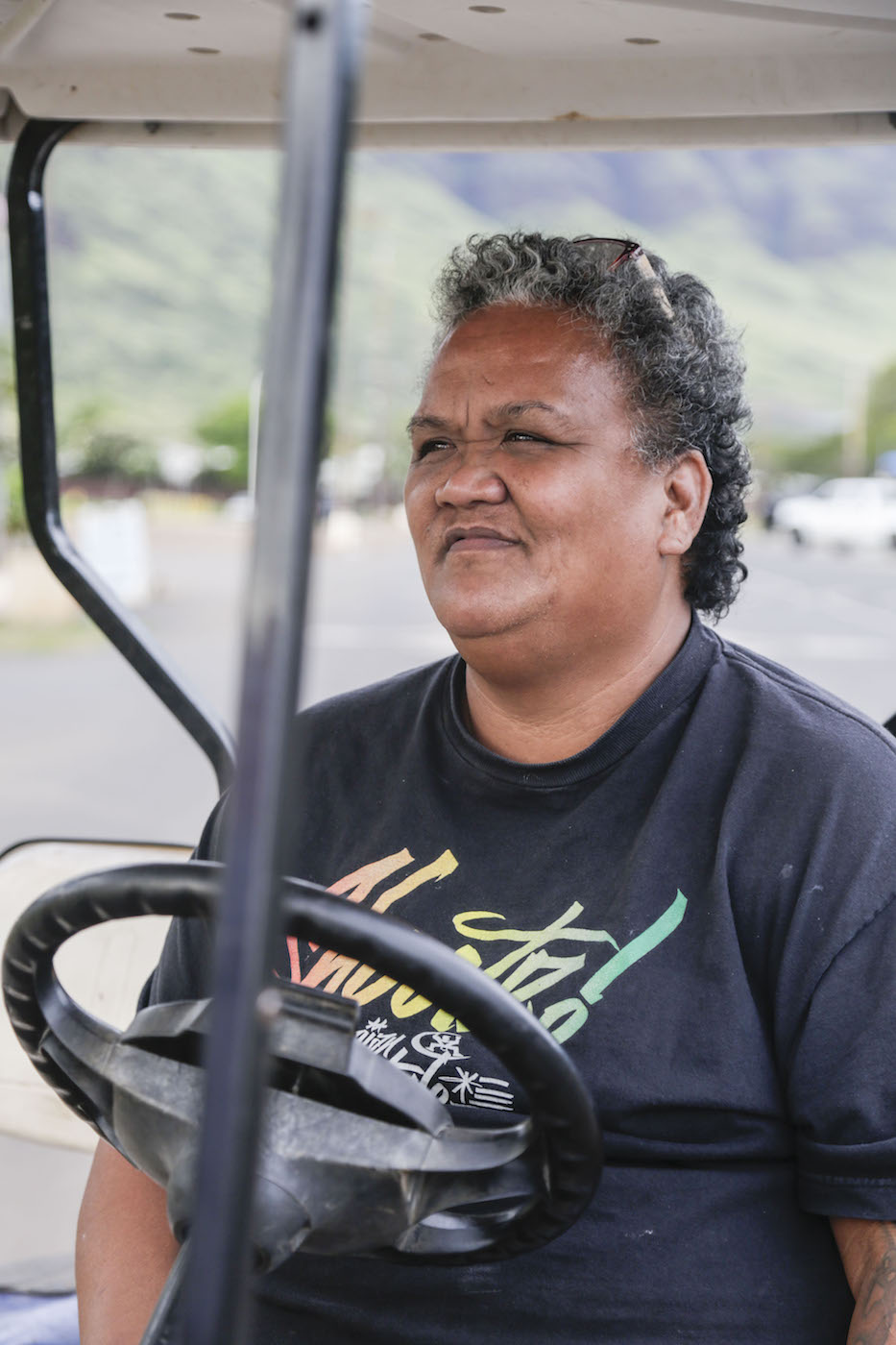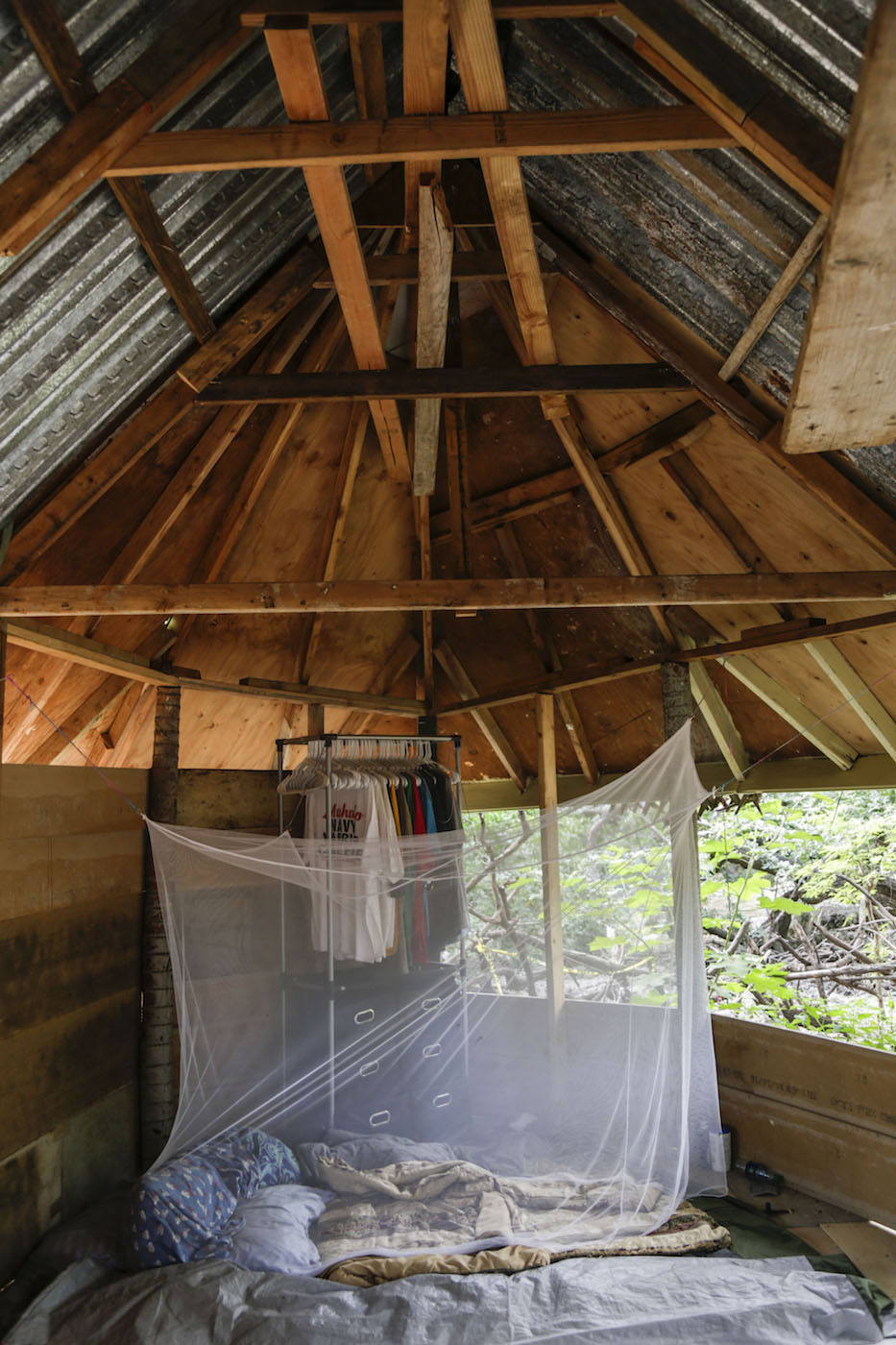As the cost of living in Hawai‘i becomes an insurmountable hurdle for some, thousands are left to pick up the pieces and patch together a new normal. Welcome to another day at the largest homeless village in Hawaii.
Images by Marie Eriel Hobro, Cidney kelly, and Lila Lee of Wolf & Woman
Sprawled across nearly 20 acres of dusty underbrush near Waiʻanae Boat Harbor, a patchwork of tents and shanties peeks out from groves of kiawe and haole koa. A battered couch sits at a main entrance, offering brief respite for those coming or going along the warren of well-trod dirt paths.
A sun-weathered man hauling a precariously loaded dolly of food picked up from a Hawaiʻi Foodbank distribution site is greeted by a small pack of children.
When he fishes out a tray of cupcakes for them, they shriek in delight. Their mothers cluck their tongues in good-natured exasperation. It’s nearly dinnertime, but they don’t protest.
Such is the amicable spirit found at Puʻuhonua o Waiʻanae, Hawaiʻi’s largest homeless encampment. Here, the residents don’t see themselves as homeless, just house-less.
As Hawaiʻiʼs increasing cost of living continues to plague local families, island residents eke out livelihoods while facing expenses that are nearly two-thirds higher than the rest of the United States.
According to a 2018 Out of Reach report from the National Low Income Housing Coalition, Hawai‘i has the highest cost of rent in the nation, and wage earners here need an hourly wage of $36.13—a far cry from Hawaiʻi’s minimum wage of $10.10—in order to afford the average two-bedroom rental.
Not surprisingly, a recent survey found that nearly half of Hawaiʻi residents live paycheck to paycheck. For many, an unexpected job loss or medical expense could land them in the red, or in the worst case, out on the streets.
For many, that worst case has already happened: For the last five years, Hawaiʻi has had the nation’s highest rate of homelessness per capita. Current estimates place the islands’ homeless population at more than 7,000.


Living like this is gonna harden you. You gotta develop a sense of strength.”
Puʻuhonua o Waiʻanae, or the Refuge of Waiʻanae, has become a mecca for those who seek safe shelter. But the living conditions are far from ideal for the 170 people or so who live there.
Residents confront a laundry list of challenges: constant exposure to the elements, no running water or electricity, rats and scorpions, too.
“Survival of the fittest? No, survival of the smartest,” says a 64-year-old woman who goes by Auntie Joey. She has called Puʻuhonua o Waiʻanae home since 2011. “Living like this is gonna harden you,” she says. “You gotta develop a sense of strength.”
Though there are a dozen or so formally registered shelters and transitional homes in Waiʻanae, those who find themselves at Puʻuhonua o Wai‘anae are drawn to its community ethos.
Managed by people who live there and not well-meaning outsiders, the village is absent of any patronizing charity. There, the focus is on compassion and connection, empathy over sympathy.
“We have rules no different from a shelter,” says Twinkle Borge, who, for the last 10 years, has helmed Puʻuhonua o Waiʻanae. “But for me, you need to have and build relationships with the people. In our village, everyone knows everyone.”
Borge was grappling with the loss of her job as a trainer for Big Brothers Big Sisters delivery drivers, as well as a broken heart from a tumultuous relationship, when she headed west in 2005.
“I was getting away from it all,” Borge says. “I just never went back.”
Back then, the area inland of the harbor was reputed as a haven for derelicts, drug users, and outcasts, not those just simply down on their luck. But Borge, who grew up in Pālolo, brought her own bit of street cred: As a teenager, she had a flair for the illicit, running an all-girl gang that stole cars and broke into houses. As an adult, she was a recovering addict.
“I needed to build bridges first with the community here,” Borges recalls. So she took initiative to connect. “I would watch people clean their areas and walk over and help.”
Her forthright, pragmatic bearing, softened by a calm and compassionate demeanor, soon earned the trust of those around her. She emerged as the guiding voice and matriarchal fulcrum of the camp. People sought her for advice, help, or sometimes just a hug.
However, as more families began arriving with young children in tow, Borge found herself thinking of the hānai son she had raised in his infancy. A safer space was needed, Borge decided. More order, too.
“It’s not their fault why [the children] are here,” Borge says. “It’s my job to protect, educate, and love them.”
Galvanizing other likeminded residents, Borge implemented and enforced strict camp rules. No sex offenders. No drugs. No stealing. No loud noises after 8 p.m. For many, the benefits of being a part of the village were worth these restrictions.
As Puʻuhonua o Waiʻanae’s population expanded, a hierarchy evolved, helping establish a chain of command to which residents could bring their concerns or requests for help. Any disagreements were mediated by either Borges or her “block captains,” a crew largely composed of women that she had tasked with managing the different sections of the village.
Infractions resulted in warnings, first verbal, then written. Serious offenses, like repeated drug use or stealing from residents, nearby businesses, or Waiʻanae High School, which sits adjacent to the camp, led to the gravest punishment of all: eviction.
“If you steal, you out,” Borge says. “We are trying to build relationships, not break them.”
Asking a resident to break down their camp and leave is a task Borge never finds easy. “It hurts more so if they have kids,” she says. Often, Borge will offer to take in the children.
As undesirable behaviors were pushed to the outer fringes of the camp (Borge estimates drug use has declined from 90 percent to about 20 percent), a marvelous effect began to happen in its interior: What was initially a casual affiliation of camp dwellers was coalescing into a cohesive community.
Residents, encouraged by the sense of structure and the feeling of being part of a larger collective, began transforming their plots into more permanent, elaborate homes, erecting low coral walls and fences, even planting gardens. People helped each other.
The able-bodied assisted kūpuna in filling water jugs, and neighbors equipped with shovels, digging sticks, and rakes worked together to clear out a resident’s tent site that had burned down.
New arrivals vetted by Borge and her captains were given a village walk-through and briefing before being assigned a site. If someone came empty-handed, essentials like bedding, a week’s-worth of food, perhaps even a tent—cobbled from the village’s donations or even the personal caches of residents—were provided.
That tenor of generosity and inclusivity continues today at Puʻuohonua o Waiʻanae, which, despite its hardscrabble exterior, feels like a tight-knit neighborhood.
——
Aristotle’s concept of the whole being more than the sum of its parts is on vibrant display during day-to-day life at Puʻuhonua o Waiʻanae.
The camp’s center operates like a town square of sorts where residents pull up metal folding chairs to talk story while children play tag and ride bikes along the dusty trails.
Just like in any other neighborhood, the kids are reminded not to trample residents’ yards lest they be scolded by their occupants. Kids being kids, the warning is lost to the breeze.


Among the camp’s 16 children are Borge’s seven hānai sons and daughters, who range in age from 2 to 15 years old. They live in Borge’s sizable multi-tent structure off the camp’s main thoroughfare.
The floor plan is cozy: an assortment of small, communal “rooms” partitioned by suspended sheets and tarps radiate outward from a makeshift kitchen.
It’s a late spring afternoon when one of Borge’s adult hānai daughters, Queenie, who lives at the camp and helps take care of the children, surveys its current state of affairs, like a parent checking to see if a child’s room is clean. In the children’s sleeping quarters, she lets out an exasperated sigh as she picks her way through a carpeted area strewn with clothes, school supplies, and toys.
In stark contrast is another child’s space a few feet over, where a mattress is stacked with carefully folded bedding and a plastic storage bin that serves as a nightstand houses neatly arranged knickknacks. “Some people are messier than others,” Queenie says with a grin.
For Borge, the welfare of Puʻuhonua o Waiʻanae’s children is paramount. Their safety, health, and happiness serve as a barometer of the village’s success. This emphasis was demonstrated six months ago, when a new family arrived to Pu‘uhonua with 8-year-old Kyhroe, who was deaf.
Unfamiliar with his new surroundings and unable to communicate with anyone other than his family, Kyhroe’s assimilation was difficult. Feelings of helplessness would frequently boil over to frustration, then rage, causing him to lash out and scream at others. Rather than ostracize Khyroe, the village sought a solution: If the boy couldn’t speak to the village, then the village would learn to speak to the boy.
Xeroxed copies of the American Sign Language alphabet soon appeared on community bulletin boards. Borge arranged for teachers from the Hawaiʻi School for the Deaf and Blind to come teach the residents how to sign. The children especially picked up the hand gestures eagerly. The village had built a bridge.
——
As the sun dips below the ocean’s horizon, young children in groups of twos and threes cheerily make their way to the Wai‘anae Small Boat Harbor parking lot. It’s time to bathe. A few teenagers trail after them, towels draped across their shoulders and plastic buckets under their arms.
Queenie explains that on school nights, children are to be washed and fed by nightfall.
The older ones are responsible for helping with the younger ones. (Borge, aware of complaints about Puʻuhonua o Waiʻanae’s contribution to the harbor’s exorbitant water bill, instructs residents to only shower and fill their water jugs after 4:30 p.m.
She also says she has offered to work with state officials to pay for the water usage.) Two young fishermen from Honolulu who had spent the day plying the west side’s premier fishing ground are rinsing off their boat while knocking back some beers.
They avert their eyes as the children expertly attach a rubber hose to one of the harbor’s four water taps. The kids initially balk at getting wet—the stream of water is ice cold.
But moments later, they’re splashing each other and dumping buckets of soapy water on each other’s shoulders. From their boat, the fishermen watch the drama unfold, their faces a thinly veiled mixture of curiosity, embarrassment, and pity.
Quietly, one wonders to his friend if the group’s toddlers had ever experienced a hot shower.
“So sad,” the friend replies, shaking his head. If the teenagers overhear this, they are nonplussed. The younger ones, now shooting the hose at each other, are oblivious. Their jubilant laughter rises up to the sky.


Wanting to check on the children, Borge zips to the parking lot in a beat-up golf cart. This cart, much like Borges’ cellphone, is an indispensable tool for managing the daily operations of the village and connecting with its residents.
When she is not using it to transport heavy supplies to campsites (or humoring the children with an occasional spin), Borge makes her rounds along the village’s myriad trails. She visits with residents to see if they might need anything, looks out for safety hazards like a precarious tree branch or a hole, and surveys areas that could be cleared for any new residents.
There’s always something to do. She admits that she feels burned out sometimes, her anxiety levels reaching points where she can’t sleep or eat, especially when she wonders of the village’s future. Ultimately she pushes through these dark periods by finding strength and solace in the community she helped to create.
“This is my home,” Borge says.
Greeting Queenie in the lot, Borge smiles broadly at the children, who are now cocooned in towels. As mother and daughter catch up on camp news, Leilei, a precocious 2-year-old, climbs atop Borge’s lap for a quick snuggle.
Queenie inquires about Borges’ plans for the evening—will she be joining for dinner? Borge says she needs to check on a complaint first. Apparently, a resident has been allowing her trash to pile up in front of her tent. Not only is it an eyesore, but it is also attracting rodents.
Trash disposal is a chronic issue and headache for Borge, especially when Puʻuhonua o Waiʻanae critics cite sanitation issues as a clarion call to disband the village. For now, residents do what they can, regularly hauling their trash to the harbor’s dumpsters until a better system can be implemented. She needs to find out what’s going on with the resident. She turns the ignition, and the cart’s engine throttles gently. Placing Leilei back with the other children, she waves and heads off.
Back in the village, all is quieting down. Generators hum against the susurrations of the evening’s light tradewinds. Sounds of dinner preparations drift from the tents.
A lamp crafted from a large plastic jug and a solar panel pad hangs from a kiawe branch. It casts a soft light on Puʻuhonua o Waiʻanae’s main path, guiding the children home.




